Wilhuff Tarkin/Legends
- "The more you tighten your grip, Tarkin, the more star systems will slip through your fingers."
- ―Leia Organa
Wilhuff Tarkin was a Human male politician and military officer who was one of the most powerful Grand Moffs in the Galactic Empire. Tarkin was a leading figure in the shaping of Imperial doctrines and was the driving force behind the creation of its key embodiment, the Death Star.
Born on Eriadu to the powerful and militaristic Human Tarkin family, the ambitious Tarkin began his career by serving in the Republic Outland Regions Security Force. He then retired and entered politics, becoming lieutenant governor of Eriadu and the Seswenna sector, before returning to the military in order to serve Supreme Chancellor Palpatine as an agent of the secret Sith Lord's New Order movement. It was in that time that Tarkin learned of his friend Raith Sienar's designs for the Expeditionary Battle Planetoid and, convinced of the potential of the design, presented Palpatine with the plans for what would become the Death Star.
Tarkin gained increasing stature as a vocal supporter of Palpatine and received notice as the Seswenna sector's governor throughout the Clone Wars. At one point, he served as a captain under Jedi General Even Piell, where he and his crew were held in the Citadel, a Separatist prison, and escaped with the help of a strike team of Jedi and clone troopers. Later on, he had been promoted to Admiral. He was present during the capture of Boba Fett after the Battle of Xagobah. In the last days of the Clone Wars, Palpatine appointed Tarkin as the first Moff, and when the Galactic Republic became the Galactic Empire, the new Emperor Palpatine gave him oversight of the construction of the Death Star. Tarkin soon formulated the Tarkin Doctrine, which helped solidify his reputation as the greatest architect of the Empire save Palpatine. The Tarkin Doctrine called for rule of the galaxy through fear of overwhelming force, and recommended the creation of superweapons such as the Death Star to create terror of Imperial reprisal that would stifle any thoughts of rebellion. Delighted, Palpatine made Tarkin the first Grand Moff, giving him control of nearly the entire Outer Rim.
As Grand Moff, Tarkin ruled with the same unyielding ruthlessness he had helped enshrine in Imperial doctrine, often cooperating with Darth Vader. As the long-delayed construction of the Death Star stalled, Tarkin created the secret Maw Installation to refine the design, placing it under the control of his mistress and protégée, Admiral Natasi Daala. With the aid of the Maw Installation's scientists, the Death Star was finally made operational in 0 BBY. Confident he could destroy the Rebel Alliance opposing the Empire, Tarkin began his campaign of fear by destroying Alderaan, a hotbed of Rebel sentiment. Tarkin then allowed prominent Rebel Princess Leia Organa, captive aboard the Death Star, to escape and lead the Death Star to the secret Rebel base on Yavin 4. There, seconds away from annihilating the Rebel headquarters, Tarkin died when Luke Skywalker destroyed the Death Star, a victim of his own belief in the Death Star's invincibility.
Biography
Ambition and ascent
Wilhuff Tarkin was born into the Tarkin family, an old, wealthy and powerful clan that had originally been granted the world of Eriadu and still remained dominant in the politics and business of Eriadu and the Seswenna sector, as well as carrying strong influence in galactic politics.[4][7] He and his younger brother, Gideon Tarkin, grew up in a family steeped in tradition, prestige, and accomplishment in politics, science, the arts, and the military.[1][7]
The Clone Wars begin
Tarkin was known for his support of Palpatine and intellectual argumentation in favor of the Chancellor's moves to consolidate power, and frequently advocated Palpatine's policies before the Galactic Senate, a venue in which he had great success.[8]
Imperial potentate
Palpatine soon arranged for Tarkin to meet with Vader to coordinate a response to the arrival of several fugitive Jedi, whom Tarkin had been monitoring, on Kashyyyk. Tarkin proposed that, rather than simply hunting down the Jedi, Vader implement a larger plan to invade Kashyyyk on the justification that it was harboring Jedi and enslave many native Wookiees for use as labor on the Death Star project. Tarkin hoped that the use of the strong and technologically skilled Wookiees would allow the project to return to pace. Vader did so, and Tarkin covertly moved the new slaves to the construction site. He reported on his cooperation with Vader to Palpatine, explaining that Imperial officers were unsure of the mysterious cyborg. Tarkin, however, was pleased with Vader, and asked permission to continue partnering with the Sith Lord.[9] Tarkin was one of few Imperial officers to see potential in cooperating with Vader, and worked closely with the Dark Lord of the Sith in the course of his career.[10]
During his tenure as Moff, Tarkin came across a report that a probe had found an isolated stable pocket within the Maw black hole cluster. Suspecting that a secret safe spot within the notoriously dangerous cluster would prove a valuable asset, Tarkin erased the report before the data was passed beyond his desk. He then sent a surveying team that found other routes into the zone and confirmed that a base could be safely built within, then had the team killed to keep the area secret. Tarkin began considering uses for the location, but did not come up with any immediately.[11] He made another acquisition when, at a fueling station on Ryloth which Tarkin was in the process of expanding into a major refueling depot for the Imperial Navy, he met Tol Sivron, an outcast former Twi'lek Clan Council member.[12][13] Tarkin took Sivron into his service and found the Twi'lek a competent manager.[12]
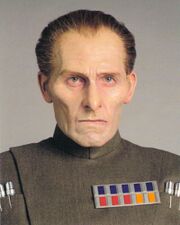
Early in Tarkin's Imperial career, high taxes on Ghorman prompted a sit-in protest at the spaceport. Tarkin, sent to collect the taxes from the defiant population, refused to yield, and landed his ship atop the peaceful protesters. Dozens were killed and hundreds injured in Tarkin's display of the consequences for defying the Imperial government. Despite public outrage at the Ghorman Massacre—which convinced Senator Bail Organa to join Senator Mon Mothma in covertly plotting rebellion against the Empire—Palpatine declined to issue Tarkin any punishment; instead, he was soon promoted.[14]
Grand Moff Tarkin
- "Rule through the fear of force rather than force itself."
- ―Wilhuff Tarkin, in the Tarkin Doctrine
In an 18 BBY personal communique to the Emperor, Tarkin proposed means to ensure Imperial security as a culmination of military and political theories he had long been developing.[16][17][15] Frustrated by cross-sector criminal and rebellious activity and the problem of jurisdictional conflicts, he called for the retooling of the oversector concept, proposing that oversectors be tailored to control unstable galactic hotspots and be assigned greater forces than usual in an attempt to root out rebellious activity before it could take hold.[16][15] Each oversector, capable of crossing sector boundaries, would be controlled by a single official who answered directly to Palpatine. The installation of HoloNet transceivers aboard all flagships within an oversector would provide enhanced communication. The philosophy of power with which Tarkin suggested unrest be fought was that of rule through fear of force, rather than direct exercise of force. Displays of power, most vitally through the use of terror-inspiring superweapons, would, Tarkin suggested, stifle dissent and rebellion. The presentation of a seemingly invincible weapon of ultimate power would play upon the fearfulness and awe of the citizenry to render all thought of assault against the Empire forgotten.[15] It was therefore Tarkin's recommendation that the Empire invest strongly and continually in the innovation of ever more powerful weapons of warfare.[18] According to this philosophy, once the Death Star was active, no one would dare act against the Empire. Terror at the prospect of planetary annihilation would ensure compliance and order.[19] Palpatine chose to officially recognize Tarkin's proposal, which became known as the Tarkin Doctrine, and Tarkin's theory became a central tenet of Imperial policy.[19][18]
The Tarkin Doctrine so pleased Palpatine that he immediately had his close aide, Imperial Advisor Ars Dangor issue a response in his name conveying the Emperor's embrace of the Tarkin Doctrine and promotion of Tarkin to the rank of Grand Moff, the position created for the officials in charge of oversectors.[15][20] Tarkin was the first man promoted to the new title.[13] He answered only to Palpatine and was given authority over Oversector Outer, an expanded version of the Greater Seswenna sector that covered nearly the entire Outer Rim and some of the Mid Rim—the largest territory of any Imperial governor—and total control of the Death Star project.[16][8][13][20] Pacifying the unruly Outer Rim Territories was considered among the most difficult assignments available in the Empire, but Tarkin was determined to tame the entire galaxy.[8]
Despite his vast responsibilties, Tarkin still found time for his personal life. Looking to advance his position, Tarkin sought out a wife. In 10 BBY he married Thalassa Motti, of the influential Motti family of Phelarion, for her contacts and money.[1] Tarkin had no love for his wife, who remained on Phelarion overseeing her family's megonite moss mines, but the Lady Tarkin was devoted to him.[1][13][21]
Around the time of his marriage, Tarkin learned of a promising tactician, whose advances had revolutionized Imperial doctrines, performing exceptionally under a pseudonym on the Caridan Imperial networks.[1][22] Tarkin began investigating, spending months and requiring the services of two underground slicers to uncover the mystery tactician's identity. He discovered that this seeming genius was in fact Natasi Daala, a Carida graduate serving as a kitchen corporal. He journeyed to Carida to meet her, and found that Daala was sure she had been shunted aside because of her sex. Seeing in her a potentially great officer, and concerned that the Caridan administration intended to transfer her to meteorological station to further hide their embarrassment at overlooking her talent, rather than promote her, Tarkin assigned her to his personal staff.[22]
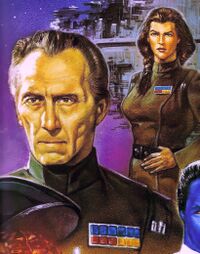
Smitten with Daala, he began an affair, finding with her the passion that his marriage to Thalassa Tarkin lacked.[1][5] In addition to being Tarkin's mistress, Daala was also his protégée; he tutored her in tactics and strategy and guided her ascent through the ranks.[19][5][23] Tarkin's relationship with Daala led to some rumors among subordinates that she had only obtained her rank by sleeping with the Grand Moff. Enraged when he overhead one young officer mutter a complaint to that effect, Tarkin had the lieutenant ejected in a spacesuit with a day's supply of air and piped his open comm over the intercom of his flagship so the entire crew were forced to listen as he raged, pleaded, and died. After that incident, Tarkin heard no further whispering.[22]
Though he spent little time on Coruscant, Grand Moff Tarkin was a major figure in the Imperial Court. He was recognized as the definitive voice on policy and philosophy, second only to Palpatine.[7] At court, Tarkin had powerful allies, such as Darth Vader, Imperial Ruling Council member Janus Greejatus, and Imperial Advisor Lord Rodin Hlian Verpalion, a close friend of Tarkin who admired the Grand Moff.[20][24][25] In addition, Tarkin cultivated a cadre of ambitious subordinates, supporters, and clients, such as Baron Merillion Tarko, whom Tarkin had promoted to the rank of Moff; Moff Ariss Lyjan of the Nuiri sector; distant relative Admiral Sander Delvardus, who commanded the Seswenna sector's fleet; and Commodore Lord Tion.[26][16][27][28][29]
As one of the Empire's most powerful men, Tarkin was involved in a great deal of intrigue. To hide his secrets from political rivals, Tarkin routed many of his more sensitive matters through the Ubiqtorate base on Yaga Minor, over which he exercised a great deal of control. He implemented two access stations on an extended walkway to keep civilian researchers out of the rest of the base, keeping his own business more secure.[30] To further protect himself, the Grand Moff kept spies within the commands of officers he mistrusted.[31] It was not only his secrets Tarkin had to safeguard, but the Emperor's as well; Tarkin was among only a handful of high-ranking figures familiar with Palpatine's secret agents, the Emperor's Hands.[32]
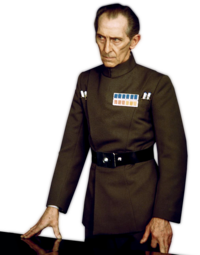
In 6 BBY, Tarkin was part of the graduation ceremony at the Academy of Carida, in which he congratulated valedictorian Han Solo and salutatorian Soontir Fel. Fel's response—that the honor of his class rank paled in comparison with the honor of serving the Empire—impressed Tarkin, and the Grand Moff made a point to watch Fel's career.[33] In the same year, Tarkin paid a visit to Viceroy Bail Prestor Organa of Alderaan, a man suspected of disloyalty to the Emperor, where he found himself struck by a water balloon dropped by Organa's daughter, Princess Leia Organa.[34]
Tarkin's exploits were not all political; he carried out the Atravis Sector Massacres, and in 5 BBY, Tarkin commanded the subjugation of defiant Mon Calamari.[1][22][35] The prominent Mon Calamari leader Gial Ackbar was enslaved and entered into the service of Tarkin's subordinate naval officer commanding the conquest. To please Tarkin, however, the officer gave Ackbar to the Grand Moff as a servant.[36] Ackbar served as a personal aide and as a chauffeur, piloting Tarkin's shuttles.[22] Tarkin came to have a vague fondness for the reliable servant, considering him like a pet.[20] He would often hold forth on his tactics to Ackbar in self-satisfaction, gloating about his plans to subjugate yet more worlds.[23]
When, in 5 BBY, Gideon Tarkin died in the Erhynradd Mutiny, Wilhuff Tarkin took Gideon's daughter, Rivoche, into his home.[1] As a girl in her early teens, with her family dead, Rivoche expressed her grief in frequent tantrums. Never a warm family man at the best of times, Tarkin disciplined his niece by sending a friendly serving girl and her family to a penal asteroid. Rivoche quickly learned to behave for her uncle, who soon sent her to an elite preparatory academy on Clær, where she learned to fill her role as an elite socialite.[37]
Building the Death Star
- "The average citizen deals in symbols, not rational analysis. If we present the citizen with a weapon so powerful, so immense as to defy all conceivable attack against it, a weapon invulnerable and invincible in battle, that shall become the symbol for the Empire. We may need only a handful, perhaps only one of these weapons to subjugate thousands upon thousands of worlds containing millions upon millions of beings."
- ―Wilhuff Tarkin, in a communique to Palpatine
Construction of the Death Star, meanwhile, had been delayed interminably by sabotage, accidents, political maneuvering, administrative roadblocks, disputes with unions, and, most importantly, problems with the plans.[19] After several years, critics began to doubt the central concept the station, the superlaser, believing it would not function. Tarkin privately worried that they might be correct.[4] In any case, it was clear that the Death Star plans contained numerous flaws.[19]
Tarkin decided that the best remedy would be to create a prototype as a proof of concept.[4] In 3 BBY, Tarkin created the Maw Installation to solve the problems in the design, complete the Hammertong Project's work by proving the superlaser, create a model Death Star, and engineer yet more superweapons.[4][16][19][5] The Grand Moff had several asteroids moved into the hidden stable zone he had found within the Maw and built a hidden scientific facility into the interlinked asteroids; the workers were then killed to keep the think tank secret.[5] He brought together a wealth of elite engineers, including head designer Bevel Lemelisk, Ohran Keldor, and Umak Leth to contribute to the design, all of whom he personally vetted.[19] Necessary scientists who did not volunteer were kidnapped.[28] Tarkin appointed Tol Sivron the director of the facility, having been impressed with the alien's managerial skills, and hired the Devaronian lawyer and administrator Yemm, whom he had met and found suitable at an Eriadu function, for an administrative position.[11][12] Tarkin altered the records of military personnel assigned to the base to list them as dead, keeping their presence secret.[28]
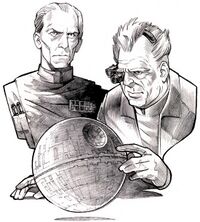
In order to maintain strict secrecy and to hide his mistress, he assigned Daala to guard the facility, with orders to remain at her post and capture or destroy any stray ships that came across the well-hidden facility.[19][5] He promoted her to admiral and presented her with four Imperial-class Star Destroyers as her fleet, personally taking her in a shuttle to observe them while under construction and impart to her the magnitude of power he was granting her.[11][5] Communication with the station was only possible through a communications circuit Tarkin controlled; the Emperor was the only other being to know of the Maw Installation's existence.[19]
Finally in a position to exploit the Omwati, he forced the planet's children to take an abilities test and collected hundreds of the highest-scoring children.[38] The primary program took ten ten-year-old children from Omwat and forced them through an advanced education program, for which Tarkin recruited noted experts Nasdra Magrody and Ohran Keldor as professors, hoping to form genius engineers.[5][35] The children labored for two years in an orbital education sphere over Omwat; those that suffered breakdowns from the tremendous pressure and pace of the accelerated program, or simply failed an examination, watched as their home cities were destroyed by orbital bombardment.[5][23] Qwi Xux was the only one to make it through the process, and Tarkin placed her at the Maw Installation under Lemelisk.[5]
Tarkin quite enjoyed Lemelisk's enthusiasm for the project, and was greatly pleased with his technological innovations. Tarkin demanded that Lemelisk's team integrate heavy defenses, comparable to those of a Core planet, into the design, and also that they ensure the station would be self-sufficient. Tarkin was disappointed that Lemelisk was not able to include much shielding in the design, but his demands were otherwise met.[20] The engineers produced an amended set of plans that solved the problems detected in the earlier specifications, and Tarkin and Lemelisk presented the revised designs to Palpatine, who was elated that the Death Star's potential was soon to be reached and approved construction of a prototype.[4][22] The design team was able to build the desired Death Star prototype as a proof of the superlaser concept, and used it to further refine the design into a form ready for renewed construction efforts.[4][19] Tarkin was delighted by the functional prototype, issuing Lemelisk, Xux, and Sivron medals immediately upon seeing their work.[12]
After nearly two decades, the Death Star was little more than an incomplete framework. With the prototype having worked out most problems with the design, Tarkin restarted work on the Death Star with new energy.[4][19] He removed Lemelisk from the Maw Installation, bringing him to oversee construction in the field.[5] Tarkin charged the remaining scientists to create yet more powerful and devastating superweapons, such as the World Devastator and Sun Crusher projects, and insisted that they be ready within nine years.[19][5] After moving the Death Star from site to site in attempts to avoid sabotage by rebels against the Empire, the station's framework was finally emplaced over the Empire's most secure prison planet, Despayre, in the Horuz system.[19] The planet's convicts were conscripted into the labor force—harshly overseen by Major Calders to Tarkin's great approval—and Tarkin assembled the largest force of construction droids in history to work toward the massive station's completion.[19][20] The Horuz system was heavily exploited for its natural resources, and fabrication systems and laboratories were erected in orbit to forge building materials and produce technical components.[19] The entire project was carried out in strict secrecy, with a strong security detail in the system and a shield generator on Despayre that projected a protective field over the Death Star's frame.[19][20] An entire branch of the Imperial Navy, Battle Station Operations, was created to man the station. Tarkin had a corps of elite soldiers created for station security, who received advanced training and were trained for intense loyalty.[20]
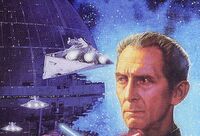
Tarkin relied upon three major aides and advisors in constructing and running the station: Admiral Conan Antonio Motti, General Cassio Tagge, and General Moradmin Bast.[19] Motti, a relative of Tarkin's wife, was his chief aide, and commanded the forces guarding the project; Tarkin believed him an overrated officer.[1][20] He had far more respect for the abilities of Tagge, the other of his two joint seconds in command, who was charged with operational security and was to be responsible for the day-to-day running of the station itself once the Death Star was operational.[8][20] Tagge's conservative belief that the Imperial Senate was necessary for the smooth running of the Empire diminished Tarkin's regard for him, however, and Tagge in turn thought little of Tarkin.[13][20] Motti and Tagge's constant feuding over military doctrine and political position frustrated Tarkin, who wanted the station to run smoothly.[16][19] Bast was Tarkin's primary personal aide.[39] Other officers were vital to Tarkin's ability to run the station as well, such as Colonel Wullf Yularen, the Imperial Security Bureau officer responsible for briefing the Grand Moff.[40]
When Lemelisk expressed dissatisfaction with the work of untrained Despayre inmates, whose shoddy work was leading to mistakes and delaying construction, Tarkin responded by executing the current workforce and bringing in strong and technically proficient Wookiee slaves.[22] In 3 BBY, Tarkin presided over another invasion of Kashyyyk, leading his forces onto the planet personally and demanding that Wookiee leaders provide workers.[22][41] When they refused, Tarkin's forces fired on the planet, rounded up Wookiees, and executed any who resisted. Tarkin kept some hostages in camps on Kashyyyk, using them to threaten the construction workers into compliance, along with drugs and negative-stimulation transmitters.[22]
Due to further delays, Darth Vader visited the under-construction Death Star for the first time, met by Tarkin and Lemelisk. Lemelisk, to Tarkin's annoyance, complained to Vader of obstruction by the Wookiee slaves, Vader reviewed the records of construction foremen and had Tarkin call a meeting of crew supervisors. In front of the others, Vader executed the two least efficient foremen and had their bodies mounted on the Death Star's framework. Tarkin was pleased to see that future construction work sped up.[22]
Tarkin, meanwhile, heard rumors that the rebellious movements against the Emperor were beginning to coordinate, and saw signs of the emergence of a unified rebel government.[20] When the Alliance to Restore the Republic was formed in 2 BBY, Tarkin was confident that the Empire, with its Death Star, would easily defeat this Rebel Alliance.[36] Seeing them as a similar threat to the Separatists of the Clone Wars, Tarkin believed that destruction of Rebel bases and cowing of those who held Rebel sympathies would be sufficient to destroy their cause, and dismissed worries that the Rebel Alliance posed a significant threat to the Empire's military, especially with the Death Star on its way to completion.[16] Rebel leader Mon Mothma, in recruiting for the Rebellion, used Tarkin's own words in speeches against the Empire, denouncing the doctrine of rule by fear.[42] Tarkin himself came under direct Rebel attack at one point in 1 BBY. His shuttle, Illirium, was scheduled to rendezvous with the Imperial-class Star Destroyer Allecto, but came out of hyperspace to find Rebel fighters attacking Allecto. The Rebels turned their attention to Tarkin's shuttle, which was safely escorted to the Star Destroyer by TIEs that eliminated the Rebel attackers.[43]
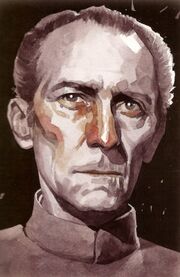
When at another point Palpatine became disappointed with delays on the Death Star, he sent Vader to convey his displeasure to Tarkin, who was at the moment supervising the Horuz system efforts from his flagship, Havelon. While Vader was in transit, Tarkin had to deal with a case of sabotage that had destroyed an oxygen tanker and damaged a major dock. Once Vader arrived, Tarkin gave the Dark Lord of the Sith a brief tour of the construction efforts, then had him interrogate the suspects in the sabotage, as Tarkin had yet to receive interrogation droids at the assembly site. Once Vader was confident that he had suppressed the sabotage activity, content that the construction was proceeding apace, he departed the system, leaving Tarkin without the annoyance of having the Emperor's watchdog present.[19]
When resources and labor for the Death Star proved insufficient, Palpatine gave Tarkin permission to divert Vader from the Sith Lord's mission at the time—investigating a traitor within the Imperial hierarchy—in order to lead the conquest of Geonosis. Once it became clear that the Geonosians had allied themselves with the Rebel Alliance, Tarkin instructed Vader to inflict punitive damage on the local population as a lesson in the consequences of rebellion. Once the planet was under Imperial control, Tarkin was able to extract the needed slaves and materials.[44]
Tarkin then received reports that ex-Imperial officer Han Solo—whose graduation as valedictorian Tarkin had attended—began raiding Imperial prisons on Kashyyyk to free Wookiees, with assistance from the Rebellion. Tarkin and Vader marshaled a response that drove Solo off the planet and saved the prisons. With Wookiee and Geonosian labor, Tarkin found himself ahead of schedule on the Death Star.[44]
Palpatine compelled both Tarkin and Vader to attend Colonel Maximilian Veers's demonstration of the All Terrain Armored Transport on Carida. Tarkin was dismissive of the weapon of war, insisting that the Death Star would supersede ground assaults, even after witnessing Veers's lone walker fend off a surprise Rebel raid on the demonstration. Palpatine, however, remained highly enthusiastic about the walker. Tarkin oversaw a retaliatory attack in response to the disruption, destroying the Rebel base on Jabiim from which the raid had been launched. The base's data archives finally revealed the identity of the Imperial official who had been collaborating with the Rebellion and had facilitated their operations at Kashyyyk and Carida: Moff Kalast. Despite evidence that Kalast may have provided the Rebellion with information about the Death Star, Tarkin was unconcerned, as he believed that the Rebels had no hope of defeating the battle station. A fleet under Tarkin attempted to arrest Kalast over Atzerri, but Kalast fled before he could be apprehended. Tarkin was able to procure an Immobilizer 418 interdictor, which allowed Vader to pin down Kalast and successfully capture the traitor.[44]
As the Death Star was building, Rivoche Tarkin held her debutante cotillion. She had begun to question her uncle's beliefs, and after the cotillion, she began spying for Alliance Intelligence, passing on secrets from Grand Moff Tarkin's household to Alliance Intelligence chief Airen Cracken, unsuspected by Tarkin—though, still loyal to her family, she refused to endanger Tarkin personally. Luckily for Tarkin, he had not shared the Death Star's existence with his niece, who spent her time socializing with her many suitors, all Imperials of high rank.[37]
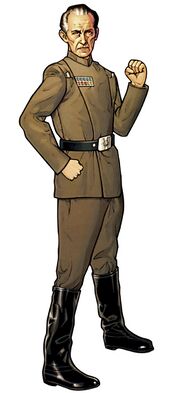
That year, Tarkin delivered the commencement address for the graduating class of Prefsbelt Fleet Camp, in which he declaimed the need to sweep away the Rebel Alliance and compel order through the exercise of raw power. He also hinted at the existence of the Death Star, to be revealed once it became operational shortly.[45] After the ceremony, Tarkin mingled with other officers at a reception and spoke with Captain Soontir Fel. Fel, who had attracted Tarkin's eye at his own graduation, had had an excellent career as a pilot and had now become a training officer at Prefsbelt IV. His cadet squadron had performed excellently, and Tarkin extended Fel an invitation to join his personal bodyguard squadron, an elite posting. When two of Fel's most promising students, Biggs Darklighter and Derek Klivian, led a mutiny and defected to the Rebel Alliance shortly into their first posting, though, Fel was disgraced, and Tarkin withdrew his offer.[33]
As Tarkin grew increasingly desirous of Daala's comforting presence at the construction site, where he was overseeing operations, he made a snap decision to summon his mistress, deciding that the Maw Installation would be safe enough without her presence. While she was present, the danger of sabotage reemerged when the Star Destroyer Undauntable suddenly exploded. Tarkin, wanting to avoid more scrutiny from Palpatine and a visit from Vader, had Motti report the incident as an accident resulting from poor maintenance of the old ship. Meanwhile, he assigned Daala to investigate the matter and unmask the saboteur herself. She was able to determine that the bomb used had been shipped through the high-security Regional Naval Supply Area at Gall and been manually triggered by a saboteur, showing a wider conspiracy with dangerous resources. Despite further investigation, though, she was unable to find the culprit, and Tarkin could keep her away from the Maw Installation no longer, so she returned.[19]
While the Death Star was under construction, Tarkin continued to think of yet more ways to battle the Rebellion.[46] He looked into interdiction technology, and working with Frap Radicon, who had helped engineer the Death Star, was able to create an advanced gravity well projector that he believed could revolutionize the war against the Rebellion.[46][47] Tarkin made plans to experiment with the technology on Delrakkin, a relatively remote world, intending to stage a Rebel attack on Delrakkin, which had begun to produce bacta for the Rebellion, in order to discredit the Rebellion as having attempted to take over Delrakkin's bacta industry. The survivors would then be given contaminated Imperial bacta, which would introduce a virus to eliminate the population and clear Delrakkin for experiments in Tarkin's new interdiction technology.[48]
Destroyer of worlds
- Tarkin: "A major part of this station's value is as a deterrent. We must prove to the galaxy that we are prepared to use it at the slightest provocation."
- Vader: "If your plan serves our purpose, it will justify itself."
- Tarkin: "The stability of the Empire is at stake. A planet is a small price to pay."
- ―Wilhuff Tarkin and Darth Vader[src]
Tarkin himself could not spend all his time supervising the construction, and returned to Eriadu. When the Death Star was nearly operational, he set out for the Death Star to take command.[20] He and Lemelisk, in a shuttle piloted by Ackbar, were ambushed by Rebel Y-wings as they left Eriadu. Ackbar shut down the shields and allowed the Y-wings to attack, telling Tarkin that this was his final revenge. Tarkin and Lemelisk ejected in an escape pod and were recovered by Motti's Star Destroyer, which arrived unexpectedly in an unsolicited effort to escort Tarkin.[22] The Rebels recovered Ackbar, causing Tarkin to mourn the loss of the previously reliable servant.[20]
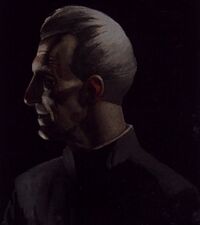
Palpatine was scheduled to arrive aboard the station for its commissioning, but decided not to travel; he would send Vader as his representative to Tarkin.[49] Knowing that Tarkin's ambition could prove dangerous, Palpatine intended that Vader would keep watch over him.[50] In fact, though Tarkin was well aware of the potential power he stood to wield as commander of the planet-destroying station and dreamed of using it to rule, he was certain that Palpatine understood the threat and had measures in place to prevent any move against his position as Emperor.[19][13] Considering the attempted overthrow of Palpatine suicidal, Tarkin had no thought of rebellion, even when several ambitious Imperials, including Motti and Imperial Advisor Greejatus, frequently attempted to subtly suggest that Tarkin use the station to seize power.[19][25]
When the Grand Moff learned that the Imperial base on Danuta had been penetrated by Rebel agents and there was a possibility that the plans for the Death Star had been stolen, he contacted Vader, who had not yet arrived on the station, and asked the Emperor's agent to determine if the plans had been stolen and, if so, recover them.[19] Tarkin then learned that a full set of blueprints had been stolen and conveyed to the Toprawa Relay Station.[22] He thought there little risk that the Rebels might be able to use the plans to destroy the Death Star, believing that they would only prove the station's invincibility. He could not, however, abide the thieves' penetration of security and defiance of the Empire.[20]
Soon after, the Lucrehulk-class carrier Fortressa arrived in the Horuz system and deployed five hundred fighters. Tarkin commanded the defense of the station, and was surprised to receive a transmission from Daala indicating that she was returning to the station and had come under attack. Seeing an opportunity to put the superlaser to work, the Grand Moff contacted Superlaser Fire Control and issued the order to target the Fortressa. The firing was a success, vaporizing the large enemy ship using only four percent of the superlaser's total power.[19]
While TIEs mopped up the enemy fighters, Tarkin received the news that Daala had suffered a head wound during the attack on her ship. He had Daala rushed to surgery and, concerned that the Rebels clearly knew the location of the station, had the Death Star moved. As it was unready for a sustained hyperspace jump, he ordered the station piloted to the other side of Despayre, its coordinates kept tightly restricted among the command staff of the Death Star and its Star Destroyer escorts. He then checked on Daala, learning from the surgical team that she had suffered brain damage that would likely cause some memory loss, but had come to no other harm. As Daala was supposed to be at the Maw, Tarkin did not want her presence at the Death Star used against him. He had all records of Daala's visit erased and, as soon as she was able, sent her back to the Maw, where she was instructed to maintain that she had never left and had suffered an injury in the course of her duties there.[19]
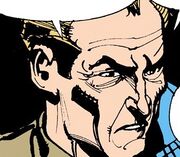
With the hull complete and interior construction nearly finished, Tarkin decided to leave the system, but insisted on testing the superlaser's destructive potential first by targeting Despayre. Though Motti questioned the decision, Tarkin believed there would be little political backlash from the obliteration of the prison world, and insisted that the weapon's power be tested before they moved on to military targets. Tarkin evacuated the military forces keeping order on Despayre, then fired. At one-third power, the beam ignited the planet's atmosphere, creating a cataclysm that killed all life on the planet. After more than an hour of recharging for each shot, second and third firings shattered the already ruined world.[19]
Vader, chasing the stolen blueprints, captured the ship that had received the transmitted plans in the Tatoo system, with Princess Leia Organa, doing her father's rebellious bidding, aboard. The plans, however, had been placed in the droid R2-D2, which had been ejected in an escape pod, and were not recovered. Vader brought Organa back to the Death Star for interrogation, intending that she would reveal the location of the secret Rebel base.[2] Tarkin signed an execution order for the young Senator immediately upon her capture, ready to kill her once her usefulness was over.[19] Vader, on behalf of the Emperor, personally conveyed to Tarkin the news that Palpatine, as Tarkin had long known he would, had abolished the Imperial Senate; the rule of the galaxy would now be fully in the hands of the gubernatorial hierarchy.[2][19][20] Tarkin announced the Senate's dissolution as he and Vader entered a meeting of the Death Star's leadership. When Motti insulted Vader's competence in regard to the stolen plans and denigrated the power of the Force, Vader used his abilities to choke the fractious admiral, until Tarkin instructed Vader to relent and moved on to his intent to destroy the Rebellion once the location of its headquarters was extracted from Organa.[2] Tarkin made a swift and brief journey to Coruscant for a meeting with members of the Death Star's design team, but the engineers were captured during the rendezvous, though Tarkin himself remained safe.[51]
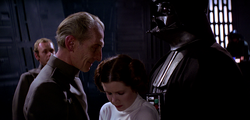
Vader made use of an IT-O Interrogator droid to question Organa, but she refused to yield the location.[2] With the Death Star at last declared operational—and Motti having once more hinted that Tarkin should overthrow the Emperor, a suggestion Tarkin again brushed off—and Palpatine having given Tarkin wide latitude to put the superweapon to use, the Grand Moff decided to compel her cooperation by holding her homeworld hostage, then destroying Alderaan—and with it the problems the peaceful world and its leader, suspected Rebel and hated enemy of Tarkin, Bail Organa, posed the Empire.[19][35][52] He directed that the station travel to the Alderaan system, where he had Leia Organa brought to the overbridge.[2] Tarkin offered her a choice: watch as the Death Star destroyed Alderaan, or give him the location of the Rebel headquarters.[2] Organa admitted the location of the base as Dantooine. Considering the undeveloped planet too minor a target, Tarkin proceeded with the destruction of Alderaan nonetheless, believing the Core World a much more significant demonstration of Imperial might and unwillingness to brook rebellion.[2] With one blast, the Death Star annihilated Alderaan, a respected ancient world and a Core Founder of the Galactic Republic, and killed Bail Organa, a key leader of the Rebellion.[16]
Tarkin dispatched scouts to Dantooine to confirm the base's location, but they found only an abandoned site; Organa had given him only the location of a former base. Outraged at his inability to force her compliance, Tarkin ordered that the Rebel woman be executed immediately. Before that instruction could be carried out, Death Star forces captured a freighter that had ventured into the Alderaan system. The Millennium Falcon, it was the same ship that had shot its way off Tatooine while suspected of carrying the Death Star plans. Vader, believing that the ship's occupants were intending to return the plans to Bail Organa on Alderaan, hatched a plan to allow the occupants to stage a rescue of Leia Organa, then let them escape with a tracking beacon aboard the Millennium Falcon. Vader was certain that they would take Organa to the Rebel stronghold, revealing it for destruction. Tarkin saw the plan as a dangerous gamble, but went along. When Vader realized that former Jedi Council member Obi-Wan Kenobi was among the passengers of the freighter, Tarkin insisted that the Jedi Master could not be allowed to escape.[2] Vader stalked off to meet Kenobi, and as Tarkin watched remotely, killed him in a lightsaber duel just before the Millennium Falcon's crew escaped with Organa.[2][19]
The homing beacon's signal led them to Yavin 4, the fourth moon of the gas giant Yavin Prime.[2] Before arriving there, Tarkin deposited on Carida the high-level design personnel who had remained aboard the Death Star to observe Alderaan's destruction and ordered Admiral Termo to take the Star Destroyer Liquidator to Delrakkin for a rendezvous with the Death Star after Yavin 4 was destroyed, intending to put his plan to eliminate the planet's population into place.[35][53] Concerned with possible delays or difficulty in reporting, Tarkin provided Termo with three holorecordings and instructions to play the recordings at certain times for his orders if the Death Star did not arrive or Tarkin did not contact him in time.[54] The third recording was in fact meant for Palpatine in the event that Tarkin should fail at Yavin, fully disclosing his interdiction advances.[46]
The Death Star emerged from hyperspace on the far side of Yavin, and began moving into range.[2] As the station closed with Yavin 4, Motti made one last attempt to flatter Tarkin's power and hinted at a coup. Tarkin demanded that Motti speak plainly, and the admiral suggested that Tarkin could at least use the threat of his control of the Death Star to secure a position as second-in-command of the Empire, or share power with the Emperor, and kill Vader. Tarkin rebuffed most of Motti's suggestions, finally stating that he would consider Motti's statements later, though without showing much interest in the proposal.[52]
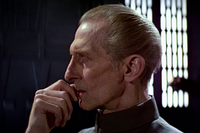
In defense, the Rebels launched a force of starfighters.[2] Tarkin, believing the small fighters could pose no threat to his gargantuan battle station, declined to intercept the fighters with TIEs, instead allowing the turbolaser defenses to deal with the fighters. Vader, less confident in the defenses, launched his personal escort of fighters.[19] When the Rebels persisted in their attack, Tarkin wondered what they were targeting, but Motti convinced him that the enemy stood no chance against Vader, who was swiftly eliminating the Rebel squadrons, and that in no case could Tarkin abandon the Death Star and show weakness; it would be political suicide.[52] When Bast informed Tarkin that an analysis had shown a weakness that the starfighters seemed to be targeting, the Grand Moff, still supremely confident in the invulnerability of his battle station, and also unwilling to risk his career if he fled and the Death Star wasn't destroyed in either case, scoffed at Bast's suggestion that he ready an evacuation ship.[2][19] Vader and his pilots shot down several Rebels, but could not prevent Luke Skywalker from firing a pair of proton torpedoes into a vulnerable thermal exhaust port.[2] Bast's analysis proved correct; as Tarkin's order to fire was being carried out and he was gleefully anticipating his moment of greatest glory—the destruction of the Rebellion by the superweapon he had so long championed—the chain reaction reached the Death Star's reactor and destroyed the battle station, annihilating Tarkin as thoroughly as he had obliterated Alderaan.[2][19]
Legacy
- "Tarkin will be remembered as a man who devoted his entire being to the Empire and Emperor that he loved more than life itself."
- ―Alendar Jarvis, writing for the New Order Progressive
With the Death Star lost, the Empire covered up its existence and suppressed any news of its defeat in the Battle of Yavin. Imperial sources alleged that Alderaan had been accidentally destroyed by a superweapon of its own construction, while Tarkin and his chief officers were announced to have died in a shuttle crash at the Tallaan Imperial Shipyards resulting from an equipment malfunction. Tarkin was lionized in reports as a steadfast, loyal, and important servant of the Emperor.[55] Satellite recordings of Alderaan's destruction, however, were smuggled out of the system by Rebel agents, and underground news sources began broadcasting the truth. The Empire quickly changed its story, announcing that the Death Star had destroyed Alderaan after finding evidence that the planet was developing a Rebel biowarfare initiative.[56] The Empire likewise admitted that there had been no accident at Tallaan, issuing warrants for Han Solo and Chewbacca, the smuggler crew of the Millennium Falcon who had returned at the last minute to cover Skywalker and allow him to destroy the Death Star, on charges of Tarkin's murder.[2][57] Instead of creating fear, the destruction of Alderaan followed by the failure of Tarkin's battle station embarrassed the Empire, stirred public outrage against the government, convinced galactic citizens that the Empire could be defeated, and inspired hope and enthusiasm among the Rebels, thoroughly backfiring.[8][14][58]
In Tarkin's absence, Termo attempted to carry out Tarkin's task at Delrakkin, but was unsuccessful.[48] Following Tarkin's recorded orders to report to Yavin after the attack if the Death Star still had not appeared, Termo was attacked and defeated by the Rebels.[59] Palpatine recovered Tarkin's third message and attempted to follow through on the project, but Rebel agents destroyed the experimental gravity well projector and killed Radicon, foiling the scheme.[60]
In the immediate wake of Tarkin's death, his surviving subordinates began to maneuver for power, fighting to inherit his vast authority, while his enemies added to the confusion by attempting to usurp his power.[8] The confusion ended when Tarkin was replaced as Grand Moff of Oversector Outer by Ardus Kaine, a similar New Order hardliner. After the death of Palpatine, Kaine turned Oversector Outer into a warlord fiefdom based on New Order principles, known as the Pentastar Alignment.[61] Admiral Delvardus, Tarkin's relative, held Eriadu and the surrounding area as the Eriadu Authority, becoming a warlord in his own right.[16]
Tarkin was survived by his wife and niece, as well as his lover Daala.[55][21][5] The Lady Tarkin was determined to avenge her husband's death, obsessed with the war against the Rebellion. She renamed the city where she oversaw the megonite moss mining operations Port Tarkin, and erected a monument in his honor.[21] Rivoche Tarkin continued as a Rebel agent for two more years before she was exposed to the Empire and extracted by the Rebel Alliance.[62] Throughout her time with the Rebellion, however, she refused to speak ill of Tarkin; she had learned well to maintain the family honor.[37]
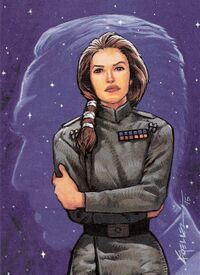
Daala spent over a decade hidden within the Maw, abiding by her orders to remain at her station and avoid contact, until Han Solo, Chewbacca, and Kyp Durron stumbled across her. She was devastated to learn that Tarkin was dead and the Death Star destroyed, and began a rampaging campaign against the New Republic, intending to use the Maw Installation's superweapons to destroy the new government.[5] She failed, but in 12 ABY, she formed the Imperial Remnant, a successor state to the Empire, with Admiral Gilad Pellaeon, himself a former subordinate of Tarkin.[12][22][63] Decades later, Daala became the Chief of State of the Galactic Federation of Free Alliances, the successor state to the New Republic. By that time she had reevaluated her former relationship with Tarkin and abandoned her formerly worshipful regard for him.[12][64]
Tarkin's death did not end the rule of the Tarkin Doctrine. Instead, Palpatine's close adviser Ars Dangor issued a declaration to the military that the Empire would inflict more terror than ever in suppressing the Rebellion.[15] Palpatine had Lemelisk begin work on another superlaser platform, dubbed the Tarkin in memory of the Grand Moff—which a Rebel team destroyed while under construction—and yet another Death Star, this one even larger and more advanced. In 4 ABY, it too was destroyed by the Rebellion, which, along with the death of Emperor Palpatine by Darth Vader's hands, dealt the Empire its most grievous blow since the Battle of Yavin.[1]
Rebel historian Voren Na'al insisted that Tarkin's loss was an irreplaceable one for the Empire.[8] Even three years later, Imperial leaders felt that Tarkin's death had left a void in the Empire's power structure.[33] Tarkin's reputation was such that, nearly a decade after his death, a physical resemblance to Tarkin was enough to inspire an instinctive respect.[57] Numerous Imperial facilities bore the Tarkin name, such as the Tarkin superweapon, Tarkin Detention Facility on Ruul, the Tarkin's Teeth training ground on Carida, Port Tower Tarkin-12 on Byss,[65] and the Deep Core fortress world Tarkin's Fang.[1][18][66][67] The Coruscant Opera on Coruscant produced a play entitled The Agony of Tarkin.[68] Tarkin was not remembered entirely positively within the Empire; among those Imperials unsettled by the destruction of Alderaan and the existence of the Death Star, some scapegoated Tarkin as a rogue agent whose use of the Death Star did not represent the Empire as a whole.[69]
On Eriadu, Tarkin was remembered with the Tarkin Memorial Conference Center in Eriadu City.[70] Tarkin's homeworld remained staunchly Imperial well into the New Republic's reign, only reluctantly capitulating to the new government once it became an economic necessity.[16] Its connection to Tarkin continued to be exploited, though. For decades, Tarkin merchandise remained available on Eriadu, including caricatured statuettes for tourists.[71]
Tarkin's legacy was not altogether negative for the Rebel Alliance. Ackbar's recovery by the Rebel Alliance provided them with numerous military secrets that Ackbar had been able to access.[36] Ackbar used the training Tarkin had unwittingly given Ackbar during his frequent discourses on tactics to his slave, his observations of Tarkin in action, and his own military genius to become Alliance Supreme Commander, a critical figure in the victory of the Rebel Alliance and New Republic over the Empire and one of the era's most noted military minds.[23][36] Also, some of Tarkin's personal journals were recovered by the Rebel Alliance, giving them critical information.[20]
Nothing could redeem Tarkin's reputation within the Rebellion and New Republic, however. Among those horrified by his atrocities, Tarkin's memory was cursed. Alderaanians especially loathed him, and the word tarkin entered Omwatese with the meaning of "demon" or "butcher."[1]
Personality and traits
Wilhuff Tarkin was a determined man with an iron will and tremendous ambition, stoked in his youth by resentment at what he perceived to be a lack of respect for the accomplishments of his Outer Rim-based family.[1][8]
Tarkin could display a charming and charismatic side when he wished, but would shift swiftly to ruthlessness when necessary.[20] In either case, he projected a dominating personal presence, and was deeply persuasive, with an aura of command nearly unmatched in the Empire.[8][72]
Though he presented a front of calmness and rational efficiency, Tarkin was exceedingly prideful, short-tempered, and capable of great spitefulness.[35] Tarkin enjoyed authority, taking pleasure in causing fear in his subordinates and telling victims of Imperial attack that they were to blame for bringing Imperial retaliation upon themselves.[20][35]
Tarkin was quite self-confident, estimating his own chances of success highly and dismissing obstacles in his path. He gloated over his successes, even before achieving them.[73] He did not like to take risks, but often considered his own position so strong as to limit the actual risk involved.[19] His incredulity at the idea that Rebel starfighters could successfully destroy the Death Star ultimately caused his death.[2] Even in his last moments, confronted with the fact that a successful proton torpedo strike would overload the reactor, Tarkin refused to accept that he could be defeated on the cusp of his climactic victory, that the superweapon on which he had so long labored could be brought low by a mere starfighter.[19] For all his confidence, though, Tarkin was willing to listen to advice from trusted subordinates; he believed that a good officer should not dismiss suggestions out of hand, and he was willing to change his position when it proved necessary.[19][23]
In his notorious Tarkin Doctrine, he articulated a slightly more nuanced view, calling for the use not of direct force, but of the fear that force would be used in order to keep the population in line. He believed that the Death Star posed so great a threat that, once it was used and its power demonstrated, no one would dare rise against the Empire.[20]
Tarkin killed those who failed him, and was willing to destroy an entire planet simply to make an example.[2][74]
A Humanocentrist throughout his life, Tarkin disliked non-Human species and also did not care for the supernatural powers of the Jedi. Though he found it distasteful, he was not above using non-Humans when they were useful, so long as Humans were the ones in control.[1][73] Tarkin's speciesism was one of the main avenues through which Palpatine, as Darth Sidious, appealed to Tarkin early in his career.[4] Even after playing a key role in formulating and articulating New Order ideology, with its emphasis on Human High Culture, Tarkin was not slavishly bound to it, and was willing to use nonhumans within the Imperial hierarchy when they proved useful.[7]
Despite these traits, he did initially have some reservations as to some of the more heinous orders from Palpatine. This ultimately resulted in Palpatine orchestrating his son's "kidnapping" (in actuality, defection) by the natives of Atoa and later death in their hands (in actuality, his death came at the hands of Darth Vader when he attempted to collapse the temple they were in in order to commit suicide) in order to make him a more vicious ally of the Empire and thus a more willing servant.[75][76][77]
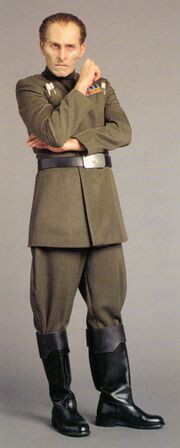
A man of tremendous intellectual power, Tarkin cultivated his mental abilities as a youth, demonstrating extensive ability in multiple disciplines. He was an accomplished philosopher and poet, and provided major developments in starship design and xenobiology.[7] A polyglot, he commanded High Galactic, Bocce, Sullustese, Shyriiwook, and Dosh in addition to his native Galactic Basic Standard.[72] Furthermore, Tarkin was adept in both the political and military fields.[73] A master of high-level politics, he was also an outstanding commander in the field, an expert in grand strategy as well as fleet and siege tactics.[19][28][78] His tactics were instrumental in the cultivation of Admiral Ackbar's military mind.[23]
Tarkin had great aptitude as an administrator. He was highly efficient and known for keeping careful track of resources and personnel, always recalling a potentially useful asset.[35] As an administrator, Tarkin took pride in his military background, believing it important to occasionally remind his subordinates that he was in fact a man of practical experience who was still willing to work in the field.[19] A skilled political jouster in addition to being a military man, Tarkin saw politics as a softer and more elegant form of warfare, but warfare nonetheless.[8][79]
Deeply devoted to the Death Star project, Tarkin saw it as his personal dream and would not tolerate obstruction of the project, especially after the frustration of nearly twenty years of delays. Defiance of his will, or simple incompetence in carrying it out, enraged him.[19] To him, the Death Star was like his own child, and he was awed by its power, passionate about its potential, and extremely proud of his accomplishment in building it.[20]
Tarkin had a close working relationship with his Emperor, of whom he had long been a major supporter.[7][55] He was willing to speak frankly to Palpatine and unafraid to disagree with the Emperor.[44] Though Tarkin was ambitious, self-confident, and of the opinion that, with the Death Star under his control, he would be the most powerful man in the galaxy, he did not underestimate the Emperor.[19] Sure that a move against the powerful and well-prepared Emperor would result only in failure, Tarkin had no real intention of overthrowing Palpatine, though he dreamed of some day being in the position to fulfill his ambitions.[19][13]
Though Tarkin had a good working relationship with Darth Vader, whom he found efficient and considered an ally in the Imperial hierarchy, he was also unsettled by Vader's supernatural powers and mysterious nature, and disliked when Palpatine used Vader as a check on Tarkin himself.[19][9][20] The pair respected but did not trust or personally like each other.[80] Despite Vader's lofty position, Tarkin was among few Imperial officials willing to interrupt, stand up to, and direct Vader, behavior Vader tolerated.[81]
Personally cold, Tarkin was not a man for trust or friendship, believing them outmoded in the new order of things. He saw connection as a matter of alliance for mutual benefit and advantage to be exploited.[73] He was not a family man, and felt little love for his wife, whom he had married purely due to political concerns.[1][37] The closest he has come to having any sense of caring for his family was with his son, Admiral Garoche Tarkin, which was exploited by Palpatine to ensure he became a more efficient officer in the Empire.[75] Tarkin was capable of some basic feelings of warmth; he saw his slave, Ackbar, much like a pet.[20] When in a mood to hold forth, Tarkin would offer instruction to Ackbar, and enjoyed explaining his own tactics to the slave.[23][79]
There was one person, though, for whom Tarkin was capable of affection. Tarkin found Natasi Daala physically appealing, but it was her intellect, ambition, and ruthlessness that drew him to her. Though he did not consider her his equal, he could not be truly attracted to a woman who was not at least close to his level in intelligence and competence. She was also the only person who could make him laugh, a trait he valued. Though he maintained a veneer of formality as her superior, their private interactions were far more casual than Tarkin's norm, and he allowed her to call him Wilhuff even in a professional setting, though before others they were always strictly formal. Tarkin allowed himself to be charmed by Daala, but he was able to resist her appeal and immediately shift to cold professionalism when circumstances demanded. In his affair with Daala, Tarkin found release from the stress of his position, seeing the admiral as an invigorating diversion from political concerns. He knew that she put her career ahead of her relationship with him, and it did not bother him; instead he considered it a sign of the driven, confident, and ruthless personality that attracted him.[19]
Behind the scenes
- "They found the only footwear they had, which was a pair of women's slippers. […] Peter was being nasty, and we're looking at him in the face trying desperately to keep a straight face. He was totally unaware what was causing the giggles. He would say, 'What's the problem? What have I done?' And we said: 'It's the shoes.' He said he couldn't do it without them, so he did the whole scene, being really evil, with us looking at him in the eyes, being very stern, while he's wearing these bloody slippers!"
- ―Don Henderson
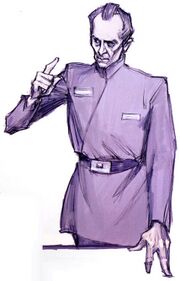
The character of Grand Moff Tarkin was created for the 1977 film Star Wars: Episode IV A New Hope, originally titled Star Wars. Tarkin, one of the film's primary antagonists with Darth Vader, was portrayed by veteran actor Peter Cushing.[2] Tarkin's name appeared in the rough draft of Star Wars as the Grande Mouff Tarkin, an Aquilaean religious leader with a single line of dialogue during a meeting of the Aquilaean Senate. The role of the villainous governor was associated with the character Crispin Hoedaack, an ambitious young official assigned to conquer Aquilae, the planet of the script's heroes. Hoedaack perished when the heroes destroyed the Imperial space fortress.[82] In the second draft, there was no governor, only Darth Vader, and the Grande Mouff Tarkin was the commander of the Kesselian Dragoons and the leader of a faction at the Rebel base that distrusted the Force connection of the Starkiller and instead relied on technological battle analysis before eventually being convinced to trust the Starkiller's battle plan.[83] In the third draft, the Grand Mouff Tarkin, commander of the Kesselian Dragoons, was the leading Rebel general, who conceived the battle plan used against the Death Star.[84] He effectively filled the role of General Dodonna in the finished film, while in this version General Dodana played the role of the cowardly and doubting general filled by Tarkin in the previous draft.[2][83][84] In the final script, the role of the villainous governor allied with Vader was restored, and writer George Lucas assigned the Tarkin name to the governor, with Dodonna as the Rebel general.[2] Once Darth Vader had become conceptualized as a masked character, Lucas believed he needed a strong, visibly human villain to complement Vader.[85] Lucas believed that Tarkin would serve the role of the main villain, serving as the personification of the Empire in the place of the Emperor himself.[86]
Cushing was originally approached to play Obi-Wan Kenobi, but Lucas decided that Cushing was perfect for the role of Tarkin, and Cushing agreed to portray the villain.[87] Cushing, who chose his roles based on what he felt viewers would like to see him do, felt that audiences would enjoy the film and like seeing him as Tarkin.[88] Cushing was Lucas's first choice for the role.[85] On set, Cushing was extremely pleasant to his co-stars, making it difficult for Carrie Fisher, playing Leia Organa, to muster the required animosity toward Tarkin's character on camera.[87] The costume department was unable to procure boots large enough for Cushing, so he wore the small boots for the few necessary long shots, but spent most of the shooting in a pair of slippers.[85] The slippers found for Cushing were women's, making it difficult for his co-stars to keep a straight face when playing against him.[87]
Tarkin first appeared not in the film, but in the novelization of the film, released months before Star Wars premiered.[81] The novel also identified his rank as Grand Moff, as did the credits of the film, but in movie dialogue he was only identified as "Governor Tarkin." Among more minor variations between the novel and the finished film, the novel portrays Tarkin as present during Leia Organa's interrogation, in contradiction of the film.[2][81] Tarkin's first name was only revealed in 1994, seventeen years after his first appearance, in Star Wars Screen Entertainment.[89]
Tarkin was voiced by Keene Curtis in the Star Wars radio drama, which included expanded scenes between Tarkin and Vader and an added subplot involving Motti attempting to convince Tarkin to overthrow the Emperor.[52] Tarkin has also been voiced by Nick Jameson in Star Wars: X-Wing.[51]
The Essential Guide to Characters listed Tarkin as having naturally black hair, and novels depicting Tarkin as a younger man shared that description.[13] Though Tarkin's hair was mostly gray in A New Hope, he still showed some hair with Peter Cushing's natural auburn color, though, and had no black in his hair.[2]
Appearances
Non-canon appearances
Sources
Notes and references
External links
- Pages with ignored display titles
- Pages with reference errors
- Pages with broken file links
- Dialogues with obsolete sourcing
- Quotes with obsolete sourcing
- Broken Mediacat category links
- Biologists
- Coruscanti
- Death Star residents
- Diplomats
- Eriaduans
- Galactic Empire science and engineering personnel
- Galactic Republic governors
- Grand Moffs of the Galactic Empire
- Humans
- Judicial Forces officers
- Males
- Philosophers
- Pilots
- Poets
- Republic Navy admirals
- Slavers
- Spies
- Tarkin family